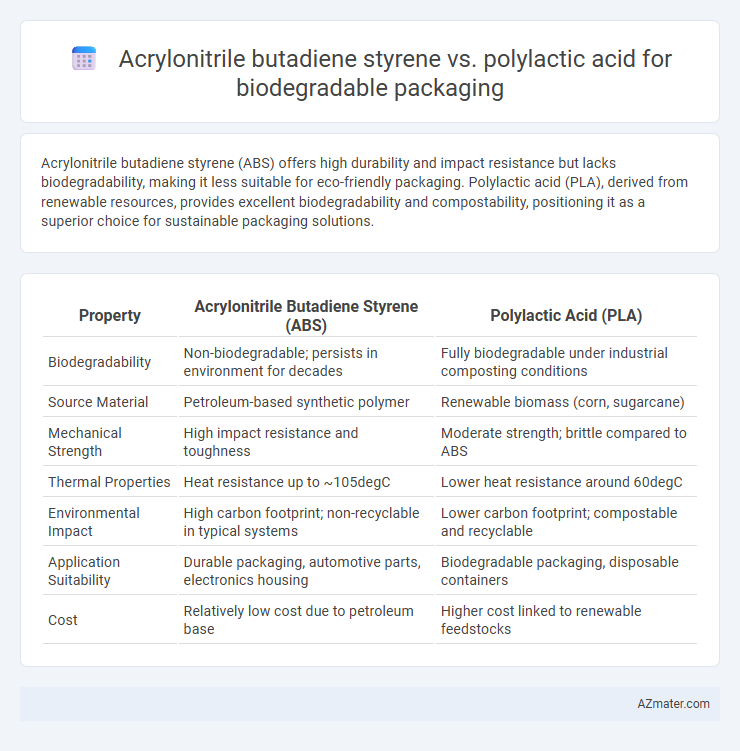Acrylonitrile butadiene styrene (ABS) offers high durability and impact resistance but lacks biodegradability, making it less suitable for eco-friendly packaging. Polylactic acid (PLA), derived from renewable resources, provides excellent biodegradability and compostability, positioning it as a superior choice for sustainable packaging solutions.
Table of Comparison
| Property | Acrylonitrile Butadiene Styrene (ABS) | Polylactic Acid (PLA) |
|---|---|---|
| Biodegradability | Non-biodegradable; persists in environment for decades | Fully biodegradable under industrial composting conditions |
| Source Material | Petroleum-based synthetic polymer | Renewable biomass (corn, sugarcane) |
| Mechanical Strength | High impact resistance and toughness | Moderate strength; brittle compared to ABS |
| Thermal Properties | Heat resistance up to ~105degC | Lower heat resistance around 60degC |
| Environmental Impact | High carbon footprint; non-recyclable in typical systems | Lower carbon footprint; compostable and recyclable |
| Application Suitability | Durable packaging, automotive parts, electronics housing | Biodegradable packaging, disposable containers |
| Cost | Relatively low cost due to petroleum base | Higher cost linked to renewable feedstocks |
Overview of Acrylonitrile Butadiene Styrene (ABS)
Acrylonitrile Butadiene Styrene (ABS) is a thermoplastic polymer known for its high impact resistance, toughness, and excellent dimensional stability, making it widely used in packaging applications requiring durability. ABS is derived from petrochemical sources and is not biodegradable, which raises environmental concerns for single-use packaging materials. Its mechanical strength and resistance to chemicals and heat contrast with biodegradable alternatives like Polylactic Acid (PLA), which offers compostability but lower durability.
Introduction to Polylactic Acid (PLA)
Polylactic Acid (PLA) is a biodegradable thermoplastic derived from renewable resources such as corn starch or sugarcane, making it an eco-friendly alternative to traditional plastics like Acrylonitrile Butadiene Styrene (ABS). PLA offers excellent clarity, strong tensile strength, and is compostable under industrial conditions, positioning it as a leading material for sustainable packaging solutions. The biodegradability and lower carbon footprint of PLA contribute significantly to reducing plastic waste and environmental impact in packaging applications.
Environmental Impact: ABS vs PLA
Polylactic acid (PLA) offers superior environmental benefits over Acrylonitrile butadiene styrene (ABS) due to its biodegradability and derivation from renewable resources like corn starch. ABS, a petroleum-based plastic, persists in the environment for centuries and contributes significantly to plastic pollution and carbon emissions. PLA's compostability in industrial facilities reduces landfill waste and lowers overall ecological footprint compared to the non-biodegradable, fossil-fuel dependent ABS.
Biodegradability Comparison: PLA and ABS
Polylactic acid (PLA) exhibits superior biodegradability compared to acrylonitrile butadiene styrene (ABS), as PLA is derived from renewable biomass such as corn starch and decomposes under industrial composting conditions within months. In contrast, ABS, a petroleum-based polymer, resists microbial degradation and can persist in the environment for decades, posing significant challenges for waste management. The rapid breakdown of PLA into non-toxic byproducts like carbon dioxide and water underscores its advantage for sustainable, biodegradable packaging applications.
Mechanical Properties and Durability
Acrylonitrile butadiene styrene (ABS) exhibits superior mechanical strength and impact resistance compared to polylactic acid (PLA), making it more durable for packaging applications requiring toughness. PLA, a biodegradable polymer derived from renewable resources, offers good rigidity and tensile strength but tends to be brittle and less resistant to heat and moisture. For sustainable packaging, PLA provides eco-friendly advantages, while ABS ensures enhanced durability and mechanical performance.
Manufacturing Process and Energy Consumption
Acrylonitrile butadiene styrene (ABS) manufacturing involves high-temperature polymerization and energy-intensive extrusion, resulting in significant carbon emissions. Polylactic acid (PLA) production relies on fermenting renewable resources like corn starch, using less energy due to lower temperature processing and simpler polymerization. PLA's biopolymer synthesis offers a more sustainable, energy-efficient alternative for biodegradable packaging compared to the fossil-fuel-based ABS.
Cost Analysis: ABS vs PLA for Packaging
Acrylonitrile butadiene styrene (ABS) generally has a higher production cost compared to polylactic acid (PLA) due to its petrochemical origin and complex synthesis processes. PLA, derived from renewable resources like corn starch, offers a more cost-effective solution in biodegradable packaging, benefiting from lower raw material expenses and evolving bio-manufacturing techniques. Despite ABS's superior mechanical properties, the economic advantage of PLA makes it the preferred option for sustainable packaging applications aiming to reduce environmental impact and lower material costs.
Safety and Regulatory Considerations
Acrylonitrile butadiene styrene (ABS) presents significant safety concerns due to its non-biodegradable nature and potential release of toxic compounds during degradation, limiting its regulatory approval for eco-friendly packaging. Polylactic acid (PLA) is favored in biodegradable packaging, benefiting from FDA and EU approvals for food contact applications and demonstrating minimal toxicity and biodegradability under industrial composting conditions. Regulatory frameworks increasingly mandate PLA's compliance with strict environmental safety standards, while ABS remains restricted due to its environmental persistence and health risks.
Real-World Applications in Biodegradable Packaging
Polylactic acid (PLA) is widely favored in biodegradable packaging due to its compostability and derivation from renewable resources like corn starch, making it ideal for single-use food containers and compostable bags. Acrylonitrile butadiene styrene (ABS), while durable and impact-resistant, is primarily used in rigid packaging where biodegradability is less prioritized, such as reusable containers and electronic casings. PLA's ability to break down under industrial composting conditions contrasts with ABS's persistence in the environment, highlighting PLA's superior suitability for sustainable packaging solutions.
Future Trends and Innovations in Sustainable Packaging
Acrylonitrile butadiene styrene (ABS) remains popular for durable packaging but faces sustainability challenges due to its petroleum-based composition and limited biodegradability. Polylactic acid (PLA) emerges as a leading bioplastic derived from renewable resources like corn starch, offering enhanced biodegradability and compostability, driving innovation in eco-friendly packaging solutions. Future trends include the development of PLA blends with improved mechanical properties, bio-based additives, and advanced recycling technologies to expand its application in sustainable packaging, replacing traditional plastics like ABS.

Infographic: Acrylonitrile butadiene styrene vs Polylactic acid for Biodegradable Packaging
 azmater.com
azmater.com